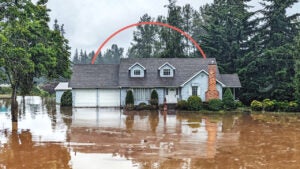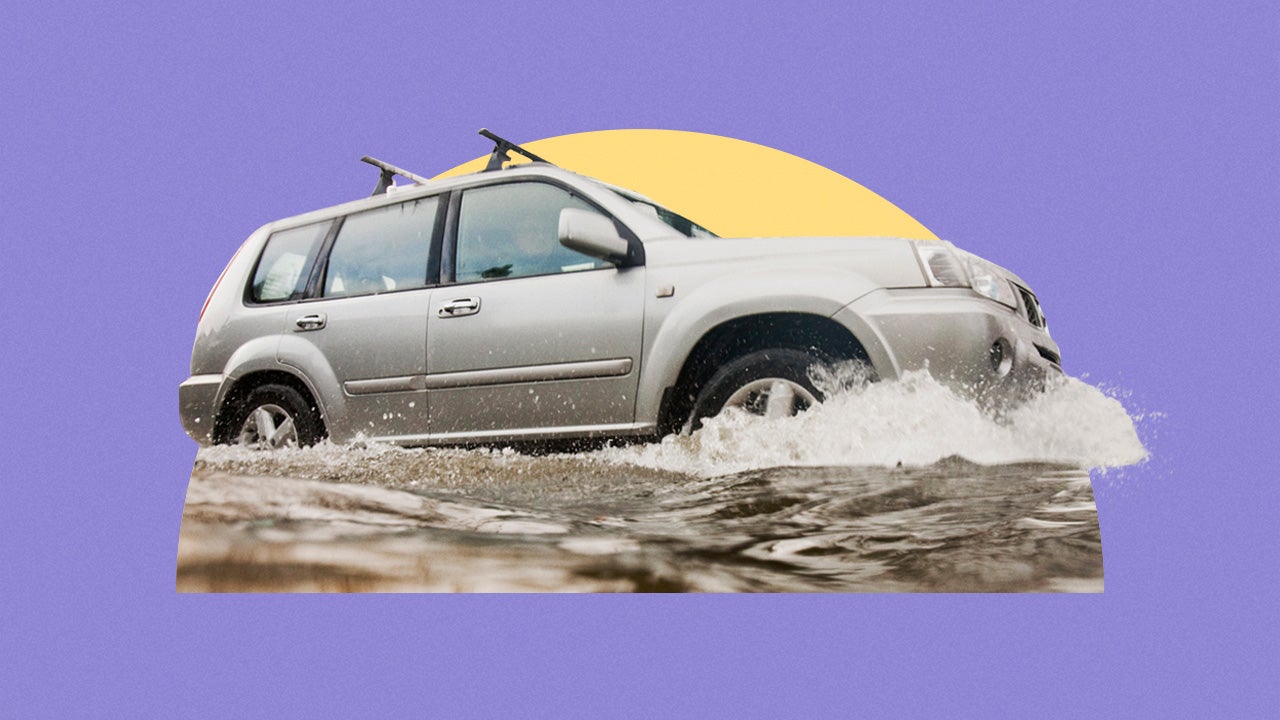How to get flood insurance coverage and who needs it

Standard home insurance policies do not include flood insurance. If you want financial protection from flood insurance, you’ll need to take out a flood insurance policy from the National Flood Insurance Program (NFIP) or a private provider. Lenders usually require flood insurance for homeowners in high-risk areas, but even lower-risk homes may benefit from this added coverage as climate change exacerbates flood risk.
How to buy flood insurance
Flood insurance policies are either underwritten by the National Flood Insurance Program (NFIP) or by a private flood insurance provider. Knowing the kind of policy you need will influence how you buy flood insurance.
NFIP policies
The Federal Emergency Management Agency (FEMA) oversees the NFIP. Many home insurance companies partner with the NFIP to offer flood insurance. You may be able to manage your policy through your home insurance provider, but the policy will be underwritten by the NFIP. To find a company in your state that sells flood coverage, you can use the flood insurance provider tool provided by FEMA. You can also contact your agent or home insurance company to check if they partner with the NFIP. NFIP policies typically come with a 30-day waiting period before they go into effect, so be sure to shop early and secure coverage before you need it.
Rates from NFIP-sponsored policies will be the same regardless of which carrier is helping you navigate the process, as the cost of flood insurance is set by the NFIP and depends on your flood zone. NFIP policies are also pretty inflexible. Coverage limits are capped at $250,000 for buildings and $100,000 for contents, and deductibles are usually $1,000. If a single-family home is insured for at least 80 percent of its replacement cost (or for the maximum amount allowed by the NFIP), the dwelling may be insured for its replacement cost value. All other dwellings and personal property are insured on an actual cash value basis.
Private flood policies
Some home insurance companies may partner with the NFIP, a private insurance company or both. For example, Allstate offers flood insurance through the NFIP and through a partnership with Beyond Floods, a private flood insurance provider. Chubb underwrites its own flood policies through Chubb Flood. If you’d prefer to work with a private flood insurance provider, you may want to speak with an agent from your home insurance company about your options. If your home insurance company does not offer flood insurance of any sort, you can reach out to a private flood insurance company directly. Here are some of the more popular providers:
- Neptune Flood
- Beyond Floods
- Chubb Flood
- Aon Edge
Working with an independent insurance agent could be helpful if you want to get private flood insurance quotes. Many private flood insurance policies are sold by specialty carriers that an independent agent may have access to. But, keep in mind that private flood insurance premiums are not preset like NFIP premiums, so costs may vary widely depending on your coverage needs.
Private flood policies sometimes offer higher coverage limits than NFIP policies. You might have more opportunities to customize your coverage, too. Plus, the waiting period could be shorter than the NFIP standard of 30 days.
It’s not a question of which policy type is better. Instead, where to buy flood insurance will depend on which one works best for you and your needs. If the $250,000 building limit offered by the NFIP offers enough coverage for you, and your community participates in the program, then the government-backed policy may be best for you. Or, if you need higher coverage limits and would like to insure your personal property at its replacement cost value, then a private policy may be a better fit. Speaking with a licensed insurance agent who is familiar with your home insurance policy can help you narrow down your options.
What to know before buying flood insurance
Before requesting a flood insurance policy quote, you may want to know some questions to ask to make sure you are getting the flood coverage you need. FEMA suggests asking your agent the following.
Does my community participate in the National Flood Insurance Program?
NFIP policies are not available everywhere. In order to qualify, your community must participate in the program. Before you decide on an NFIP policy, be sure that one is available to you.
What flood zone do I live in?
Flood zones range from low-risk to high-risk. Technically, everyone is in a flood zone, although your zone may be the lowest possible risk level. It is important to understand your flood risk level to make an informed decision about your coverage. FEMA’s flood map tool lets you put in your address or coordinates to find out what flood zone your property is in.High-risk areas are marked with zones beginning with A or V, whereas moderate- to low-risk areas are marked as B, C or X. Keep in mind that if you live in a higher-risk flood zone, your mortgage company will likely require a flood insurance policy just like a homeowners insurance policy to account for potential flood damage.
What does a flood insurance policy cover?
Flood insurance policies only cover damage from natural flooding, not from an overflowing toilet or broken pipe. If you need more clarification, FEMA’s definition of a flood may help sort things out. According to FEMA, a flood occurs when at least two acres of normally dry land are covered in standing water due to natural events or when standing water occurs due to a collapse of land along the shoreline of a natural body of water.There are several types of flood insurance, and the kind you have will dictate what’s covered.
Building property coverage
This type of coverage provides financial protection in the event the following incurs damage:
- The structure of your house
- The electrical and plumbing systems
- Central AC, furnaces, vacuum systems, etc.
- Refrigerators and built-in appliances
- Permanently installed carpeting
- Window blinds
- Detached garages
Building coverage is capped at $250,000 for an NFIP policy and has a $1,000 baseline deductible. If you want the items inside your house to be covered under your flood policy, you’ll have to purchase an additional type of coverage: personal property (or contents) flood coverage.
Personal property flood coverage
This covers most personal belongings or anything that is inside the house up to $100,000, including:
- Clothing, furniture and electronic equipment
- Curtains
- Portable air conditioners and window units
- Carpets not included in building coverage
- Washers and dryers
- Food freezers and the food in them
- Valuables like artwork and fur (up to $2,500)
It is important to note that personal property stored in a basement or outside in a yard will not be covered by an NFIP policy. NFIP policies have other notable personal property exclusions:
- Lawns, trees, shrubs and plants
- Fences, retaining walls, outdoor swimming pools and docks
- Underground structures like wells and septic tanks
- Accounts, bills, currency, deeds and money
- Vehicles and aircraft
For some homeowners, it may be worth looking into an excess flood insurance policy. In some cases, excess flood insurance may even cover costs to pay for preventive flood measures or additional living expenses in the event of a covered loss.
Can I get discounts on flood insurance?
While you won’t find the same common discounts on a flood insurance policy that you would for a homeowners insurance policy, there are flood insurance discounts available. Depending on the building structure and the rating categories you fall into based on FEMA’s designations, you may qualify for one or more flood insurance discounts with the NFIP. Your home or building’s foundation type, first-floor height, built-in flood openings and methods of mitigation all factor into potential discounts. Generally, the higher the building is off the ground, the lower the flood risk and the greater the discount.
You may also be eligible for a discount if you’re a part of any particular FEMA programs or ratings groups — such as the Emergency Program or the Community Rating System (CRS). CRS communities are those that have taken steps to reduce and prevent flood damage to insured properties and developed comprehensive floodplain management.
Flood insurance for renters
Renters can also purchase flood insurance to help cover the risk to their belongings. Flood insurance for renters is typically more affordable because it only covers the tenant’s personal property, not the structure of the home. The process for getting flood insurance for renters is similar to those for homeowners. The NFIP offers rental flood insurance with coverage of up to $100,000. How much the policy costs will vary depending on your location relative to flood risks, how close to the first floor you are and how much coverage your policy provides.
Frequently asked questions
Why we ask for feedback Your feedback helps us improve our content and services. It takes less than a minute to complete.
Your responses are anonymous and will only be used for improving our website.
You may also like

FR-44 insurance: What it is and when you need it

HO-2 homeowners insurance policies

Soon you can pay your flood insurance premium monthly. Should you?

Does car insurance cover flooding damage?


